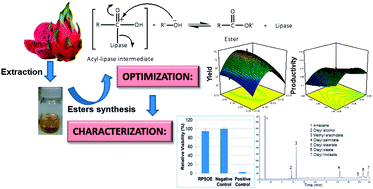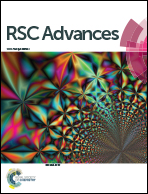Lipase-catalyzed synthesis of red pitaya (Hylocereus polyrhizus) seed oil esters for cosmeceutical applications: process optimization using response surface methodology
Abstract
Esters were synthesized via the alcoholysis of red pitaya seed oil with oleyl alcohol catalyzed by immobilized lipase, Lipozyme RM IM. The effects of synthesis parameters, including temperature, time, substrate molar ratio and enzyme loading, on the yield and productivity of esters were assessed using a central composite response surface design. The optimum yield and productivity were predicted to be about 80.00% and 0.58 mmol h−1, respectively, at a synthesis temperature of 50.5 °C, time of 4 h, substrate molar ratio of 3.4 : 1 and with 0.17 g of enzyme. Esters were synthesized under the optimum synthesis conditions; it was found that the average yield and productivity were 82.48 ± 4.57% and 0.62 ± 0.04 mmol h−1, respectively, revealing good correspondence with the predicted values. The main esters were oleyl linoleate, oleyl oleate, oleyl palmitate and oleyl stearate. The synthesized esters exhibited no irritancy effects and their physicochemical properties showed their suitability for use as cosmeceutical ingredients.



 Please wait while we load your content...
Please wait while we load your content...